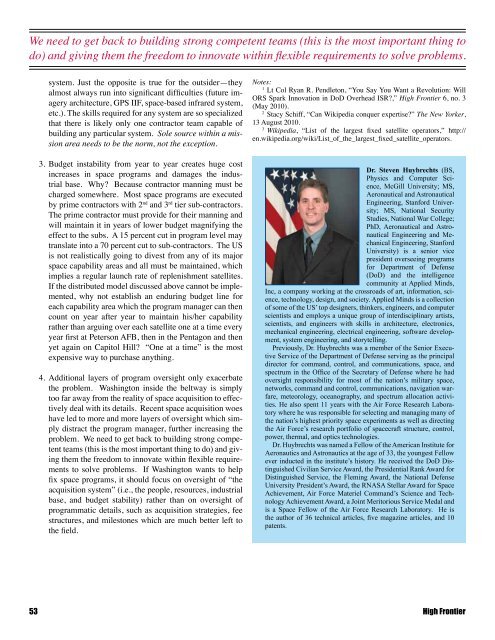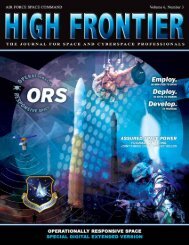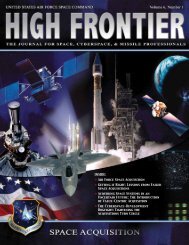Schriever Wargame 2010 - Air Force Space Command
Schriever Wargame 2010 - Air Force Space Command
Schriever Wargame 2010 - Air Force Space Command
- No tags were found...
Create successful ePaper yourself
Turn your PDF publications into a flip-book with our unique Google optimized e-Paper software.
We need to get back to building strong competent teams (this is the most important thing to<br />
do) and giving them the freedom to innovate within flexible requirements to solve problems.<br />
system. Just the opposite is true for the outsider—they<br />
almost always run into significant difficulties (future imagery<br />
architecture, GPS IIF, space-based infrared system,<br />
etc.). The skills required for any system are so specialized<br />
that there is likely only one contractor team capable of<br />
building any particular system. Sole source within a mission<br />
area needs to be the norm, not the exception.<br />
3. Budget instability from year to year creates huge cost<br />
increases in space programs and damages the industrial<br />
base. Why Because contractor manning must be<br />
charged somewhere. Most space programs are executed<br />
by prime contractors with 2 nd and 3 rd tier sub-contractors.<br />
The prime contractor must provide for their manning and<br />
will maintain it in years of lower budget magnifying the<br />
effect to the subs. A 15 percent cut in program level may<br />
translate into a 70 percent cut to sub-contractors. The US<br />
is not realistically going to divest from any of its major<br />
space capability areas and all must be maintained, which<br />
implies a regular launch rate of replenishment satellites.<br />
If the distributed model discussed above cannot be implemented,<br />
why not establish an enduring budget line for<br />
each capability area which the program manager can then<br />
count on year after year to maintain his/her capability<br />
rather than arguing over each satellite one at a time every<br />
year first at Peterson AFB, then in the Pentagon and then<br />
yet again on Capitol Hill “One at a time” is the most<br />
expensive way to purchase anything.<br />
4. Additional layers of program oversight only exacerbate<br />
the problem. Washington inside the beltway is simply<br />
too far away from the reality of space acquisition to effectively<br />
deal with its details. Recent space acquisition woes<br />
have led to more and more layers of oversight which simply<br />
distract the program manager, further increasing the<br />
problem. We need to get back to building strong competent<br />
teams (this is the most important thing to do) and giving<br />
them the freedom to innovate within flexible requirements<br />
to solve problems. If Washington wants to help<br />
fix space programs, it should focus on oversight of “the<br />
acquisition system” (i.e., the people, resources, industrial<br />
base, and budget stability) rather than on oversight of<br />
programmatic details, such as acquisition strategies, fee<br />
structures, and milestones which are much better left to<br />
the field.<br />
Notes:<br />
1<br />
Lt Col Ryan R. Pendleton, “You Say You Want a Revolution: Will<br />
ORS Spark Innovation in DoD Overhead ISR,” High Frontier 6, no. 3<br />
(May <strong>2010</strong>).<br />
2<br />
Stacy Schiff, “Can Wikipedia conquer expertise” The New Yorker,<br />
13 August <strong>2010</strong>.<br />
3<br />
Wikipedia, “List of the largest fixed satellite operators,” http://<br />
en.wikipedia.org/wiki/List_of_the_largest_fixed_satellite_operators.<br />
Dr. Steven Huybrechts (BS,<br />
Physics and Computer Science,<br />
McGill University; MS,<br />
Aeronautical and Astronautical<br />
Engineering, Stanford University;<br />
MS, National Security<br />
Studies, National War College;<br />
PhD, Aeronautical and Astronautical<br />
Engineering and Mechanical<br />
Engineering, Stanford<br />
University) is a senior vice<br />
president overseeing programs<br />
for Department of Defense<br />
(DoD) and the intelligence<br />
community at Applied Minds,<br />
Inc, a company working at the crossroads of art, information, science,<br />
technology, design, and society. Applied Minds is a collection<br />
of some of the US’ top designers, thinkers, engineers, and computer<br />
scientists and employs a unique group of interdisciplinary artists,<br />
scientists, and engineers with skills in architecture, electronics,<br />
mechanical engineering, electrical engineering, software development,<br />
system engineering, and storytelling.<br />
Previously, Dr. Huybrechts was a member of the Senior Executive<br />
Service of the Department of Defense serving as the principal<br />
director for command, control, and communications, space, and<br />
spectrum in the Office of the Secretary of Defense where he had<br />
oversight responsibility for most of the nation’s military space,<br />
networks, command and control, communications, navigation warfare,<br />
meteorology, oceanography, and spectrum allocation activities.<br />
He also spent 11 years with the <strong>Air</strong> <strong>Force</strong> Research Laboratory<br />
where he was responsible for selecting and managing many of<br />
the nation’s highest priority space experiments as well as directing<br />
the <strong>Air</strong> <strong>Force</strong>’s research portfolio of spacecraft structure, control,<br />
power, thermal, and optics technologies.<br />
Dr. Huybrechts was named a Fellow of the American Institute for<br />
Aeronautics and Astronautics at the age of 33, the youngest Fellow<br />
ever inducted in the institute’s history. He received the DoD Distinguished<br />
Civilian Service Award, the Presidential Rank Award for<br />
Distinguished Service, the Fleming Award, the National Defense<br />
University President’s Award, the RNASA Stellar Award for <strong>Space</strong><br />
Achievement, <strong>Air</strong> <strong>Force</strong> Materiel <strong>Command</strong>’s Science and Technology<br />
Achievement Award, a Joint Meritorious Service Medal and<br />
is a <strong>Space</strong> Fellow of the <strong>Air</strong> <strong>Force</strong> Research Laboratory. He is<br />
the author of 36 technical articles, five magazine articles, and 10<br />
patents.<br />
53 High Frontier











